在2019年Google I/O大会上,Google 宣布今后将优先采用 Kotlin 进行 Android 开发。
一,简介
Kotlin 是一种富有表现力且简洁的编程语言,不仅可以减少常见代码错误,还可以轻松集成到现有应用中。
Google 列举的 Kotlin 的优势:
- 富有表现力且简洁:可以使用更少的代码实现更多的功能。表达自己的想法,少编写样板代码。
- 更安全的代码:Kotlin 有许多语言功能,可帮助你避免null指针异常等常见编程错误。
- 可互操作:可以在 Kotlin 代码中调用 Java 代码,或者在 Java 代码中调用 Kotlin 代码。Kotlin 可完全与 Java 编程语言互操作。
- 结构化并发:Kotlin 协程让异步代码像阻塞代码一样易于使用。协程可大幅简化后台任务管理。
更重要的是,Jetpack Compose 仅支持 Kotlin,而不再支持 Java。 Google 提到多平台项目可使用 Kotlin 来开发。
二,概念介绍
1. 包的定义和使用
包的定义应该写在文件的顶部。
package com.rustfisher.ktpractice.intro
import kotlin.text.*
// ...Kotlin并不要求包名和文件存放位置严格对应。
2. 程序入口
Kotlin应用的程序入口是main方法。
fun main() {
// ..
}另一个main方法带有参数
fun main(args: Array) {
// ...
}3. 标准输出
print方法将传入的变量打印到标准输入流。
print("Rust ")
print("Fisher")println打印传入变量并且在最后添加一个换行。
println("an.rustfisher.com")
println(42)4. 方法
下面是一个接受2个Int参数,返回Int的方法。
fun sum(a: Int, b: Int): Int {
return a + b
}方法主体可以是一个表达式。它的返回值可以被推断出来。
fun sum(a: Int, b: Int) = a + b方法可以没有返回值,或者说是返回一个无意义的值(Unit)。
fun printSum(a: Int, b: Int): Unit {
println("sum of $a and $b is ${a + b}")
}Unit可以忽略不写。
fun printSum(a: Int, b: Int) {
println("sum of $a and $b is ${a + b}")
}5. 变量
只能读的变量需要用关键字val。它们只能被赋值1次。
val a: Int = 1 // 直接赋值
val b = 2 // 自动推测出是Int类型
val c: Int // 当没有赋初始值时,需要声明类型Type required when no initializer is provided
c = 3 // 这里是推迟赋值可以多次赋值的变量用关键字var
var x = 5 // 自动推测出是Int型
x += 1可以在顶部声明变量
val PI = 3.14
var x = 0
fun incrementX() {
x += 1
}6. 创建类与实例
定义一个类,使用class关键字
class Fisher类的属性可以放在定义中或者类里。比如下面这个类Rectangle,描述长方形。
class Rectangle(var height: Double, var length: Double) {
var perimeter = (height + length) * 2
}默认构造器中的变量可以直接使用。这里可以直接使用面积变量perimeter
val rectangle = Rectangle(5.0, 2.0)
println("The perimeter is ${rectangle.perimeter}")对于kotlin v.1.4.30,类的继承用冒号:来表示。类默认都是final的,不可继承。为了继承,用open让这个类能被继承。
open class Shape
class Rectangle(var height: Double, var length: Double): Shape {
var perimeter = (height + length) * 2
}7. 注释
和其他现代编程语言类似,用//或者/**/来注释
// 这服务器托管网里是注释 RustFisher
/**
* 这是注释
*/
/* 这也是注释 */8. 字符串模版(String tempplates)
直接使用变量,用$
要使用表达式,需要用大括号${}
var a = 1
// 简单使用$
val s1 = "a is $a"
a = 2
// 使用方法
val s2 = "${s1.replace("is", "was")}, but now is $a"9. 条件表达式
fun getMax(a: Int, b: Int): Int {
if (a > b) {
return a
} else {
return b
}
}Kotlin中,if也可以写成一个表达式
fun getMax(a: Int, b: Int) = if (a > b) a else b10. for循环
使用in
val items = listOf("apple", "banana", "kiwifruit")
for (item in items) {
println(item)
}使用下标
val items = listOf("apple", "banana", "kiwifruit")
for (index in items.indices) {
println("item at $index is ${items[index]}")
}for (i in 1..3) {
println(i)
}
for (i in 6 downTo 0 step 2) {
println(i)
}11. while循环
val items = listOf("apple", "banana", "kiwifruit")
var index = 0
while (index 12. when表达式
when看起来有点像Java里的witch,但这两个是不同的东西。
fun describe(obj: Any): String =
when (obj) {
1 -> "One"
"Hello" -> "Greeting"
is Long -> "Long"
!is String -> "Not a string"
else -> "Unknown"
}13. 范围
检查一个服务器托管网数字是否在范围中,使用in操作
val x = 10
val y = 9
if (x in 1..y+1) {
println("在范围内")
}检查一个数是否超出了范围
val list = listOf("a", "b", "c")
if (-1 !in 0..list.lastIndex) {
println("-1 超出了范围")
}
if (list.size !in list.indices) {
println("list的size也超出了下标范围")
}遍历一个范围
for (x in 1..5) {
print(x)
}指定步进值
for (x in 1..10 step 2) {
print(x)
}
println()
for (x in 9 downTo 0 step 3) {
print(x)
}14. 集合
遍历一个集合
for (item in items) {
println(item)
}检查集合中是否包含某个对象,用in操作
when {
"orange" in items -> println("juicy")
"apple" in items -> println("apple is fine too")
}用lambda表达式对集合进行filter和map操作
val fruits = listOf("banana", "avocado", "apple", "kiwifruit")
fruits
.filter { it.startsWith("a") }
.sortedBy { it }
.map { it.toUpperCase() }
.forEach { println(it) }15. 可为null的值和null检查
可以为null的变量,后面需要一个问号?
下面这个方法返回Int或者null
fun parseInt(str: String): Int? {
// ...
}使用可能返回null的方法(上面那个方法)
fun printProduct(arg1: String, arg2: String) {
val x = parseInt(arg1)
val y = parseInt(arg2)
// Using `x * y` yields error because they may hold nulls.
if (x != null && y != null) {
// x 和 y 经过null检测后自动变成了非null值
println(x * y)
}
else {
println("'$arg1' or '$arg2' 不是数字")
}
}或者写做
// ...
if (x == null) {
println("参数错误 arg1: '$arg1'")
return
}
if (y == null) {
println("参数错误 arg2: '$arg2'")
return
}
// x 和 y 经过null检测后自动变成了非null值
println(x * y)16. 类型检查和自动转换
用is来检查某个对象是不是某个类型。 如果确定某个不可变的变量的类型,那后面使用它的时候不用再显式转换
fun getStringLength(obj: Any): Int? {
if (obj is String) {
// obj已经自动转换为String类型
return obj.length
}
// 这里的obj仍然是Any类型
return null
}或者用!is
fun getStringLength(obj: Any): Int? {
if (obj !is String) return null
// 这里的obj已经自动转换为String类型
return obj.length
}再换个写法
fun getStringLength(obj: Any): Int? {
// 这里面的obj已经自动转换为String类型
if (obj is String && obj.length > 0) {
return obj.length
}
return null
}最后分享一份《史上最详Android版kotlin协程入门进阶实战》
目录
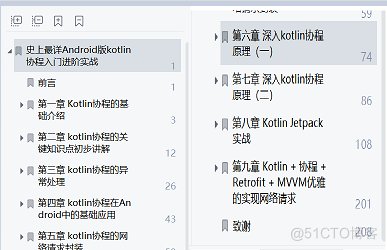
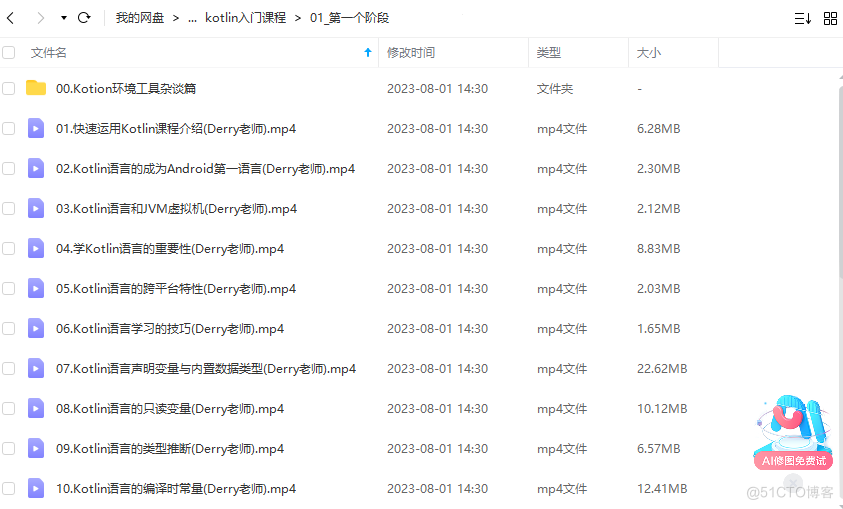
第一章 Kotlin协程的基础介绍
- 1.1 协程是什么
- 1.2 什么是Job 、Deferred 、协程作用域
- 1.3 Kotlin协程的基础用法

第二章 kotlin协程的关键知识点初步讲解
- 2.1 协程调度器
- 2.2 协程上下文
- 2.3 协程启动模式
- 2.4 协程作用域
- 2.5 挂起函数

第三章 kotlin协程的异常处理
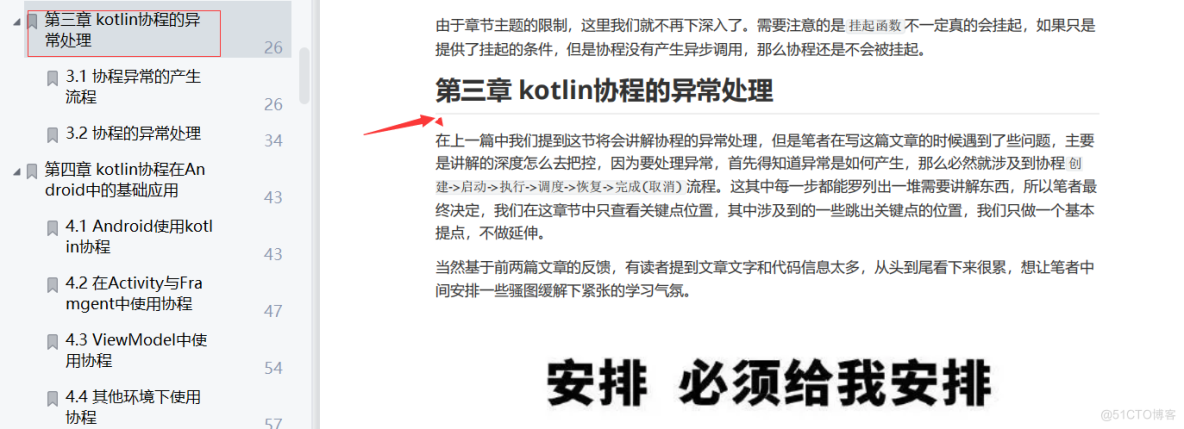
第四章 kotlin协程在Android中的基础应用
- 4.1 Android使用kotlin协程
- 4.2 在Activity与Framgent中使用协程
- 4.3 ViewModel中使用协程
- 4.4 其他环境下使用协程

第五章 kotlin协程的网络请求封装
- 5.1 协程的常用环境
- 5.2 协程在网络请求下的封装及使用
- 5.3 高阶函数方式
- 5.4 多状态函数返回值方式
- 5.5 直接返回值的方式
第六章 深入kotlin协程原理(一)
- 6.1 suspend 的花花肠子
- 6.2 藏在身后的- Continuation
- 6.3 村里的希望- SuspendLambda

第七章 深入kotlin协程原理(二)
- 7.1 协程的那些小秘密
- 7.2 协程的创建过程
- 7.3 协程的挂起与恢复
- 7.4 协程的执行与状态机
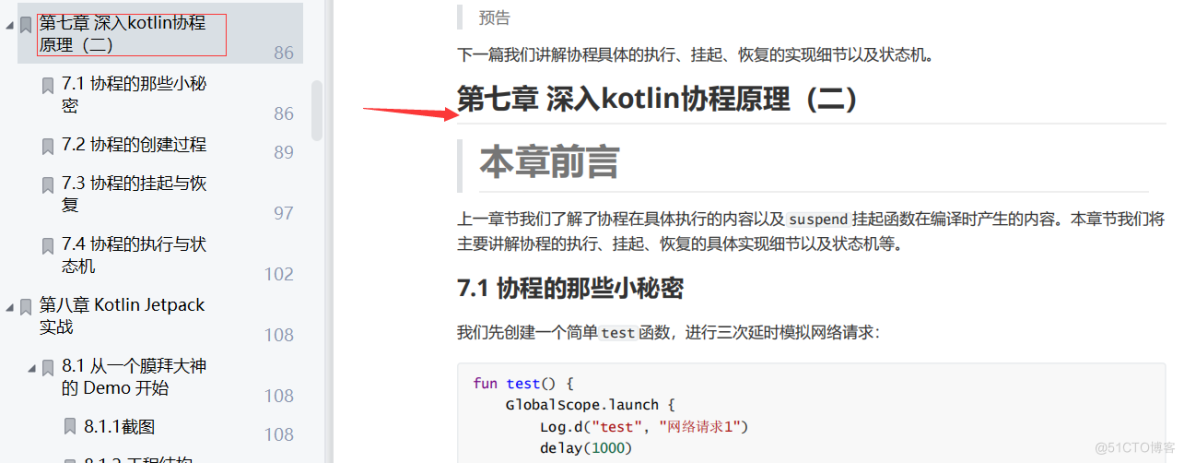
第八章 Kotlin Jetpack 实战
- 8.1 从一个膜拜大神的 Demo 开始
- 8.2 Kotlin 写 Gradle 脚本是一种什么体验?
- 8.3 Kotlin 编程的三重境界
- 8.4 Kotlin 高阶函数
- 8.5 Kotlin 泛型
- 8.6 Kotlin 扩展
- 8.7 Kotlin 委托

第九章 Kotlin + 协程 + Retrofit + MVVM优雅的实现网络 请求
- 9.1 项目配置
- 9.2 实现思路
- 9.3 协程实现
- 9.4 协程 + ViewModel + LiveData实现
- 9.5 后续优化
- 9.6 异常处理
- 9.7 更新Retrofit 2.6.0
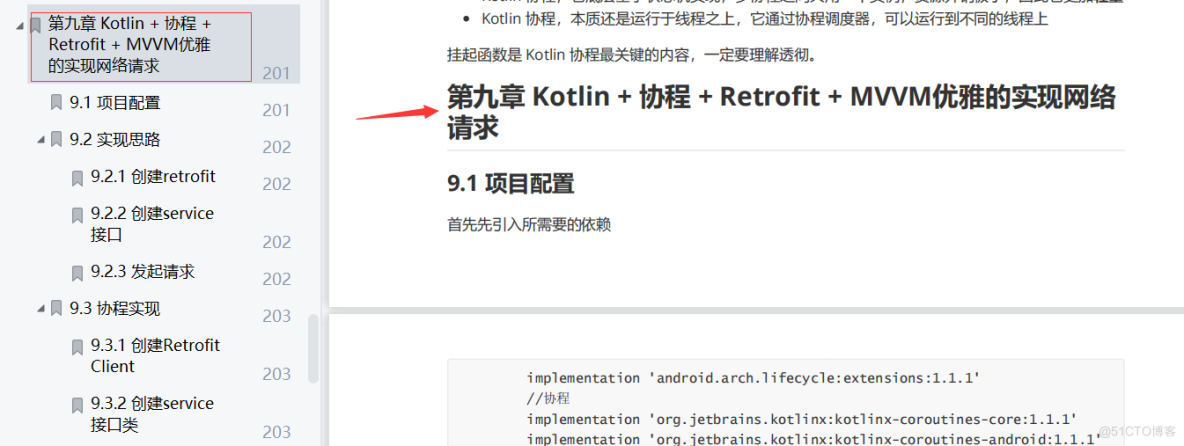
服务器托管,北京服务器托管,服务器租用 http://www.fwqtg.net
机房租用,北京机房租用,IDC机房托管, http://www.fwqtg.net

